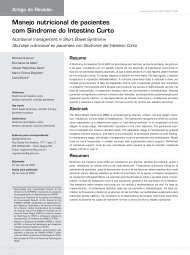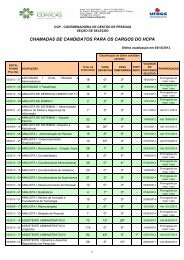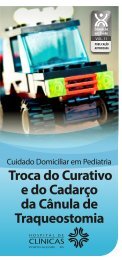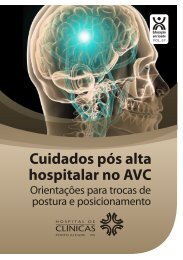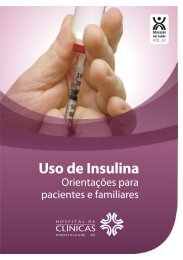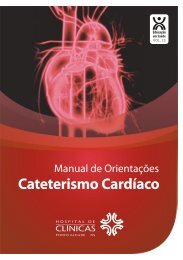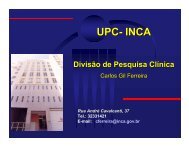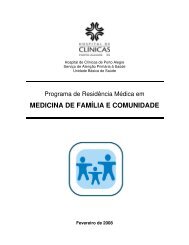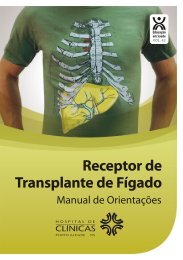Anais da 27º Semana CientÃfica - Hospital de ClÃnicas de Porto Alegre
Anais da 27º Semana CientÃfica - Hospital de ClÃnicas de Porto Alegre
Anais da 27º Semana CientÃfica - Hospital de ClÃnicas de Porto Alegre
Create successful ePaper yourself
Turn your PDF publications into a flip-book with our unique Google optimized e-Paper software.
206<br />
Revista HCPA 2007; 27 (Supl.1)<br />
away the <strong>de</strong>eper layers of white matter progressively in a lateromedial direction, and various association, projection, and<br />
commissural fibers were <strong>de</strong>monstrated. As the dissection progressed, photographs of each layer were obtained. Special attention<br />
was given to the optic radiation and to the sagittal stratum of which the optic radiation is a part. Our observations agree with two<br />
articles published previously: 1) The optic radiation covered the entire lateral aspect of the temporal horn as it extends to the<br />
occipital horn. 2) The anterior tip of the temporal horn was covered by the anterior optic radiation along its lateral half. 3) The<br />
medial wall of the temporal horn was free from optic radiation fibers, except at the level at which these fibers arise from the<br />
lateral geniculate body to ascend over the roof of the temporal horn. 4) The superior wall of the temporal horn was covered by<br />
optic radiation fibers. 5) The inferior wall of the temporal horn was free from optic radiation fibers anterior to the level of the<br />
lateral geniculate body. CONCLUSIONS: The study of optic radiations through fiber dissection technique is paramount to<br />
un<strong>de</strong>rstand the complex anatomical knowledge necessary in temporal lobe procedures, such as amyg<strong>da</strong>lohippocampectomy.<br />
MICROSURGICA ANATOMY OF THE CAVERNOUS SINUS TRIANGLES WITH CASE ILLUSTRATION OF A<br />
CAVERNOUS SINUS MENINGEOMA<br />
GUSTAVO RASSIER ISOLAN MD, PHD; LEANDRO INFANTINI DINI MD, FRANCISCO BRAGA MD<br />
OBJECTIVES: Parkinson´s and Dolenc's <strong>de</strong>scriptions of surgical entry points into the cavernous sinus have been adopted by most<br />
surgeons operating in this region. However, authors differ in naming and <strong>de</strong>scribing some of the triangular spaces. The purpose of<br />
this study is to present the <strong>de</strong>tailed anatomy of the ten triangles cavernous sinus area and report a case of a patient with cavernous<br />
sinus meningeoma METHODS: Eight formalin ca<strong>da</strong>veric heads and four skull bases were dissected using 3X to 40X<br />
magnification of the microscope. In the heads, a cranioorbitozygomatic approach was ma<strong>de</strong> and a combined extra- and intradural<br />
approach was performed and triangles i<strong>de</strong>ntified. A 63 years-old female presented with hea<strong>da</strong>che, partial third nerve palsy, V1<br />
hypoesthesia and visual impairment on the right si<strong>de</strong> in the last year. MRI showed a right parasellar tumor involving right<br />
cavernous sinus with orbital and small clivus invasion. A cranio-orbital-zygomatic with middle cranial fossa peeling was<br />
performed to obtain proximal control of the intrapetrous internal carotid artery. The anterior clinoid process and the orbital roof<br />
were drilled out. The tumor was almost totally ressected (except the part adherent to the oculomotor nerve) through parkinson's,<br />
oculomotor and Mullan triangles. There were no postoperative complications. There were no new <strong>de</strong>ficits except the third nerve<br />
palsy which was partial and now, after a month, is total . The right eye visual impairment improved consi<strong>de</strong>rably. RESULTS: The<br />
triangles were i<strong>de</strong>ntified, <strong>de</strong>limited and <strong>de</strong>scribed. CONCLUSIONS: The normal anatomy of the CS triangles is important in the<br />
approach of the CS lesions because these spaces are natural corridors through which the lesions insi<strong>de</strong> CS can be reached.<br />
Whenever the CS triangles can be distorted by pathology or surgical maneuvers, the surgeon must have a precise knowledge<br />
about these spaces.<br />
MICROANATOMY AND SURGICAL APPROACHES TO THE INFRATEMPORAL FOSSA - AN ANAGLYPHIC THREE-<br />
DIMENSIONAL STEREOSCOPIC PRINTING STUDY<br />
GUSTAVO RASSIER ISOLAN MD, PHD; RICHARD ROWE MD; OSSAMA AL-MEFTY MD<br />
The infratemporal fossa (ITF) is a continuation of the temporal fossa between the internal surface of the zygoma and the external<br />
surface of the temporal bone and greater wing of the sphenoid bone that is sitting <strong>de</strong>ep to the ramus of the mandible. In this study,<br />
we <strong>de</strong>scribe the microsurgical anatomy of the ITF, as viewed by step by step anatomical dissection and also trough the perspective<br />
of three lateral and one anterior surgical approach. METHODS: Eight ca<strong>da</strong>ver specimens were dissected. In one si<strong>de</strong> of all<br />
specimens an anatomical dissection, where a wi<strong>de</strong> preauricular incision from the neck on the anterior bor<strong>de</strong>r of the<br />
sternoclidomastoid muscle at the level of the cricoid cartilage to the superior temporal line was done. The flap was displaced<br />
anteriorly and the structures of the neck were dissected followed by a zygomatic osteotomy and dissection of the ITF structures.<br />
The anatomical dissections were documented on the three-dimensional (3D) anaglyphic method to produce stereoscopic prints.<br />
RESULTS: The anatomical structures are presented. In our dissections the maxillary artery was lateral to the buccal, lingual and<br />
the inferior alveolar nerves. We found the second part of the maxillary artery superficial to the lateral pterygoid muscle in all<br />
specimens The anterior and posterior branches of the <strong>de</strong>ep temporal artery supply the temporal muscle. In two cases we found a<br />
middle <strong>de</strong>ep temporal artery. CONCLUSIONS: The IFT is a complex region on the skull base that is affected by benign and<br />
malignant tumors. Although the authors have shown four approaches, there are a variety of approaches and even the combination<br />
among these can be used. This type of anatomical knowledge is paramount to choose the best approach to treat lesions in this<br />
area.<br />
AVALIAÇÃO DO ENVOLVIMENTO DE CÉLULAS-TRONCO AUTÓLOGAS DE MEDULA ÓSSEA NA REGENERAÇÃO<br />
DO NERVO TIBIAL DE COELHOS MEDIANTE TÉCNICA DE TUBULIZAÇÃO COM PRÓTESE DE SILICONE<br />
LUCAS MARQUES COLOMÉ; CRISTIANO GOMES, NADIA CROSIGNANI, ANA HELENA PAZ, ANA AYALA LUGO,<br />
KARINA MAGANO GUIMARÃES, LIZIANE PINHO FOERSTROW, JARDEL PEREIRA TESSARI, LETÍCIA MARQUES<br />
COLOMÉ, DOMINGUITA LÜHERS GRAÇA, LUISE MEURER, EDUARDO PANDOLFI PASSOS, NEY LUIS PIPPI,<br />
EMERSON ANTONIO CONTESINI, ELIZABETH OBINO CIRNE LIMA<br />
Neste estudo é apresentado um mo<strong>de</strong>lo experimental <strong>de</strong> <strong>de</strong>feito agudo em nervo periférico para avaliação <strong>da</strong> regeneração nervosa<br />
mediante técnica <strong>de</strong> tubulização associa<strong>da</strong> à inoculação <strong>de</strong> células-tronco autólogas <strong>de</strong> medula óssea. Foram utilizados 12 coelhos<br />
Nova Zelândia albinos, submetidos à secção bilateral do nervo tibial e posterior reparo mediante utilização <strong>de</strong> câmara <strong>de</strong> silicone.<br />
Internamente à prótese <strong>de</strong> tubulização do nervo tibial esquerdo em todos os animais, foram inocula<strong>da</strong>s células-tronco autólogas <strong>de</strong><br />
medula óssea, coleta<strong>da</strong>s a partir do úmero. Como grupo controle (nervo tibial direito), mediante aplicação <strong>de</strong> mesma técnica <strong>de</strong><br />
reparo, solução <strong>de</strong> NaCl 0,9% foi administra<strong>da</strong> internamente à prótese. Após 30 dias <strong>de</strong> observação, os animais foram<br />
eutanasiados e proce<strong>de</strong>u-se à avaliação histológica dos segmentos nervosos através <strong>da</strong>s colorações <strong>de</strong> hematoxilina-eosina, luxol<br />
fast blue e azul <strong>de</strong> toluidina. Com os resultados, foi possível concluir que o transplante <strong>de</strong> células-tronco autólogas associado à<br />
técnica <strong>de</strong> tubulização apresenta vantagens no processo <strong>de</strong> regeneração nervosa periférica.




